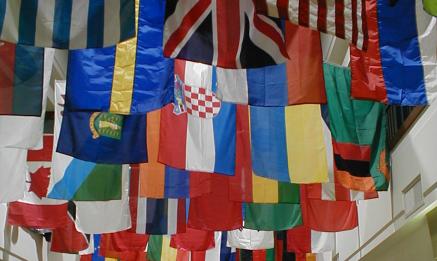A real international classroom

With a grant from the American Collaborative Online International Learning (COIL) Program, professor Marca Wolfensberger from Hanze University of Applied Sciences in Groningen started the project two years ago in collaboration with the Marymount University in Arlington, Virginia. In the Global Village project students from both countries experience what it means to follow classes together with fellow students from another continent.
Logistic challenge
Creating a perfectly functioning international classroom proved to be rather difficult, not in the last place because of the time difference. “Because of this time difference students in Arlington always have to follow classes early in the morning, while their Dutch colleagues study in the afternoon.” That is challenging, and it is not the only problem students face. “It’s interesting to see how big the cultural differences between the two groups really are.”
Wolfensberger, together with some Dutch colleagues, visited New York last week to elaborate on their contribution to the COIL-program. With the support of Hanze UAS she hopes to continue the project the coming years, and with a bit of luck even expand it. “It would be great if we could also start to cooperate with a school in, for example, Antwerpen or with schools in other American cities.”
So far, the first version of the project has been a great success, also for the researchers that cooperate in the project who obtained a lot of insightful information from the project. That is also one of the specific goals Marca Wolfensberger set for the Global Village project. As a professor in educational excellence she is doing a great deal of research on educational innovation. The research on how students and teachers perceive this project is of great importance to Wolfensberger. “The discussion on the project with colleagues is very valuable to us as well.”
Bringing people together
Last year, part of the lessons were about migration flows, Wolfensberger recalls. “What struck us was the fact how little migrants Dutch students actually know, while the American class had a lot of second-generation immigrants. When you bring these two groups together in field research, you also see how different insights come together. That is an important goal of this project.”
The cooperation in the classroom feels very close because of the television screens. “You are really in the same classroom. As a teacher and initiator of the project, I am very aware of these differences,” Wolfensberger notes. “When and how do you respond to an email? Or, for example, how important are grades? And how to deal with deadlines? By working together so intensively, you really create an ethical and cultural consciousness by these students.”
Not aware of the differences
It is remarkable to see that students often think they are well aware of cultural differences, because they have traveled around the globe. “American students don’t tend to travel as much as Dutch students do, but also Dutch students learn in this course that they are not really that aware of the differences as they think.” Next to that, students from both sides of the Atlantic indicated that they had difficulties with intercultural and online communication.
At the seminar in New York there was a lot of enthusiasm for the method Wolfensberger and her colleagues developed. She also received a lot of feedback that will help her to improve the project in the future. “Our students are writing a blog in which they record their experiences. In New York, someone from SUNY, Brockport NY told me she is teaching 150 students who would really like to respond on our blog. That way students from different parts of the world can give each other feedback as well.”
Meest Gelezen
Vrouwen houden universiteit draaiende, maar krijgen daarvoor geen waardering
Hbo-docent wil wel rolmodel zijn, maar niet eigen moreel kompas opdringen
Wederom intimidatie van journalisten door universiteit, nu in Delft
‘Waarom het nu niet lukt om medezeggenschap in hbo te versterken’
‘Sluijsmans et al. slaan de plank volledig mis’

